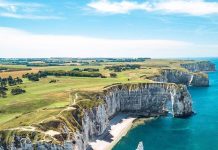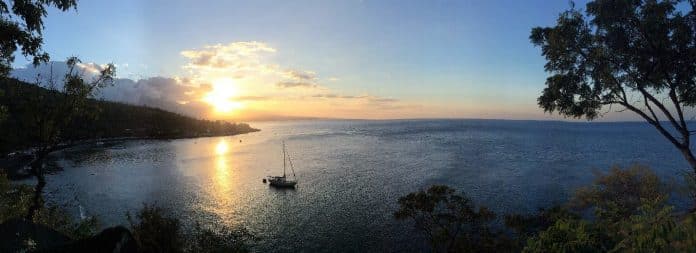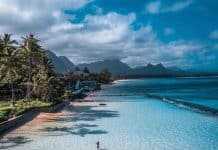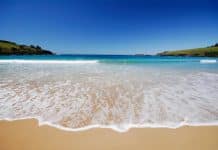Bali reached international fame some time ago. It has long been a destination for surfers, tropical island lovers, and those looking for a temporary (sometimes permanent) escape from reality. In this sense, Bali is old news – however, Bali never gets old.
This South East Asian island has a certain mystic about it that has been drawing travelers, tourists, and ex-pats for decades. Is it the ocean’s swell? The unique mix of Hinduism, Buddhism, Islam, and Christianity? Or perhaps it’s the near-perfect weather, practically guaranteeing year-round beach lounging.
No one would blame you for taking off to Bali. I’m guilty of it a few times myself. But it wasn’t for any of the above-listed reasons. While I certainly have nothing against surfing and sunbathing, my draw to Bali was for a completely different reason: Scuba diving.
What’s so good about diving in Bali?
I’ve done quite a bit of diving in South East Asia. As an employed dive instructor, I’ve jumped around from the east and west coast of Thailand to the Perhentian Islands in Malaysia. I’ve gone on multiple dive vacations to exotic places like Borneo, to the deep waters of the Philippines, to random, unplanned dive trips off of Koh Rong, Cambodia.
But there was always something about the idea of Bali that excited me more than all these places. Bali’s got it all; reef and wreck dives, deep water, current, massive schools of fish, sharks, turtles, small and crazy looking creatures, and tons of other tropical marine life.
Starting point
I was traveling with my boyfriend during my first trip to Bali. We were both employed in Malaysia as dive instructors and were in need of a short vacation. What better place, we thought, than Bali. It was just a short flight away and we were especially excited to check out some new dive sites.
We flew into Depansar International Airport and immediately jumped in a van to take us northeast.
I’d heard a lot about Bali, particularly the crazy party scene of Kuta, located in the south of the island near the airport. Kuta attracts backpackers and young Australians with promises of wild and cheap beach parties. Not really my scene anymore. We decided to skip this party animal’s hot-spot and head to a quieter part of the island.
TIP: If you’re not into the tacky tourist scene, get as far away from Kuta/Depansar/Seminyak as possible. Built up resorts, westernized restaurants, and countless souvenir shops as far as the eye can see are all you’ll find here.
So, where should you go? I’m glad you asked…
A Peaceful Haven
We’d done some research before arriving in Bali and knew we didn’t want to stay in the south with the 18-year old spring breakers. We settled on a small village called Amed, a 2 ½ hour drive from Depansar Airport, on the far east coast of the island. It looked small, quaint, quiet, and most importantly, was in close proximity to some amazing dive sites.
Amed
When we arrived in Amed, it was exactly what I’d be hoping for; narrow roads, mom and pop style restaurants, and cozy accommodation options. We picked Kadek Homestay, a small family run guesthouse in the middle of the “main drag” (if you could call it that). The property was shrouded in a garden jungle and backed directly onto the beach.

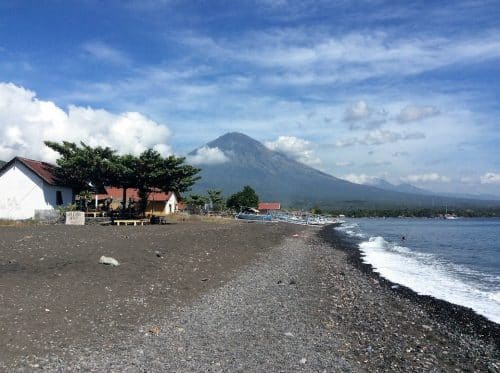
The first of many special things I noticed about Amed was the black, volcanic sand. It makes sense once you look up and see the powerful and prominent Mount Agung towering over Amed. The dark color of the sand gives the whole beach an edgier, more curious appearance– I couldn’t wait to see how that translated underwater!
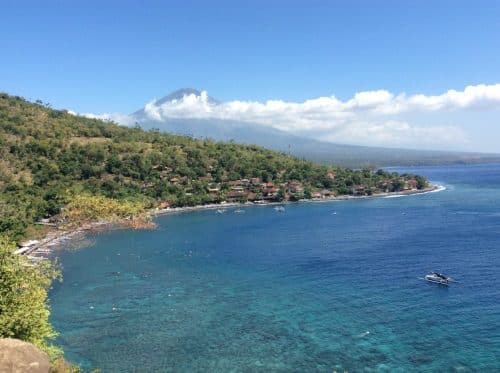
Diving in Amed
Amed is, by far, the most laid-back place for diving I have ever visited. You would be hard-pressed to find a place that’s more easy-going.
As card-carrying PADI dive instructors, we had all our own scuba gear with us. The only things we needed were a few weights and two tanks. We wandered into a dive shop just a few hundred meters from our guesthouse and chatted with the employees for a few minutes. They recommended a few dive sites that were just down the road and off the beach. Because we were dive professionals, we were able to go diving safely on our own. The dive shop rented us two tanks for $5 each and threw in a couple of kilo weights for free.
We stacked the tanks sideways on the floor of our rented scooter, wore as much of our gear as possible, and balanced the rest on the handlebars as we took off in the direction of the beach.
Pyramids
We found the spot the folks in the dive shop had described to us – a dive site known as “Pyramids.” We assembled our gear on the side of the road, used the references the dive shop had given us for an entry point and walked into the sea.
As soon as we were underwater it felt like we were on the cusp of a night dive; the black sand and twinkling sun on the surface was reminiscent of a sunset dive. We descended down, looking for the man-made pyramid-like structures we were told about. As the current pushed us along, the first pyramid came into view.
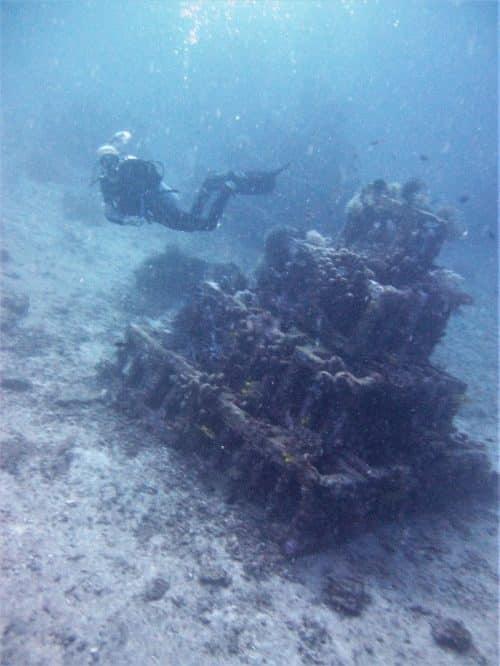
Suddenly there was a pop of color. It came from the bright soft corals that consumed the structure. Angelfish, moorish idol, trumpet fish, and damselfish flitted happily around. Upon closer inspection, we found dozens of small, colorful creatures like nudibranch and shrimp.
After a few laps, we drifted along to the next pyramid, then the next. More awesome soft corals, sand-burrowing string rays and flounders, and tons of colorful fish.
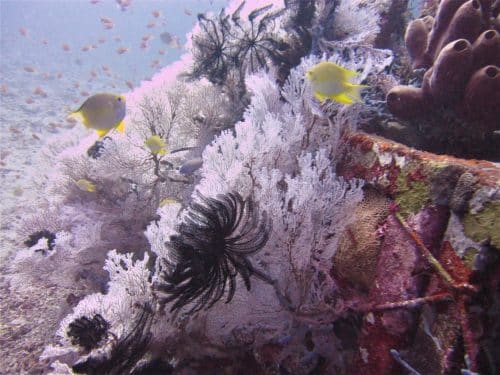
After we surfaced we had a quick swim to shore, dissembled our gear and hopped on the bike again. I couldn’t get over how such a simple and easy procedure could yield such a great dive. I didn’t know it yet, but it was about to get easier and better….
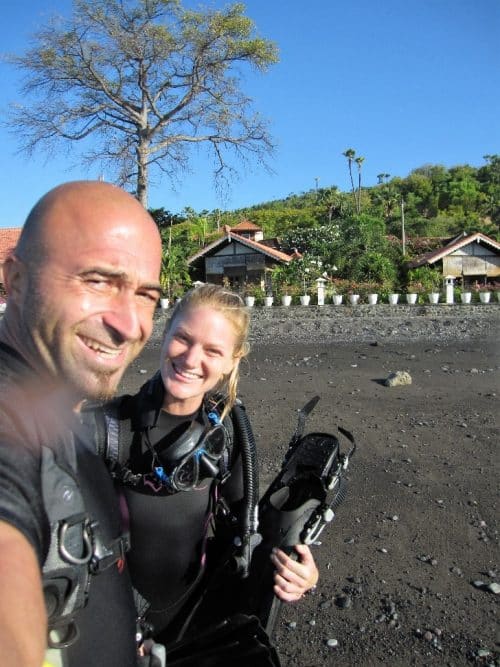
The U.S.S. Liberty
If you’ve done any research about diving in Bali, you’ve read about this world-class wreck dive. The U.S.S. Liberty sits literally just off the beach in Tulamban, the neighboring village of Amed.
We decided to dive the U.S.S. Liberty the next day at sunrise in order to beat the crowds – as the most sought-after dive in Bali, we knew by mid-day the site would be mobbed with divers.
We managed to get our hands on a phone number to a local who delivered tanks to dive sites. We called, thinking this was too good to be true. Sure enough, the man on the other end confirmed the story. So, we thought we’d push our luck – did he have 15-liter tanks instead of the typical 12-liter? Yes, he did. Did he have Nitrox? Of course. Could he deliver two 15-liter Nitrox tanks to the U.S.S. Liberty dive site tomorrow morning at 6 am? No problem.
The next morning, we met our “tank guy” in the parking lot. He rolled up with our tanks and an analyzer to check the oxygen level of our Nitrox tanks. All good. He stated for us to call him when we were finished and he’d come pick up the tanks. Our dive at one of the most famous dive sites in the world cost us $7 each.

Once our gear was assembled we walked down to the beach. A local pointed us in the general direction of the wreck.

The Dive
We experienced one of the best dives of our lives in the next 80-minutes. The wreck itself is staggering. It’s 120-meters long and has been sunk for over 50 years. The top of the wreck sits at 5-meters and the deepest point is roughly 30-meters.
There are many wide-open areas to safely swim through, over, and under the ship. The shimmering black sand sets a fantastic background for the vibrant soft coral that has grown all over the wreck. The pink, white, and purple fluorescents seem to light up the whole area.
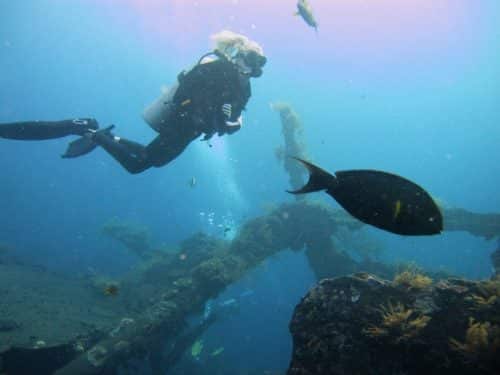

And, oh my goodness, the marine life – schools of snapper, trevally, and hump head parrot fish patrol the grounds. Colorful angelfish, giant puffers, and porcupine fish drift lazily by. Red-tooth triggerfish flutter around and sea snakes twist their way by. The wreck is also crawling with exotically colored nudibranch and shrimp. The site is like an ancient, underwater playground. Simply beautiful.
One of the coolest parts of the dive was the garden of snake eels in the shallows. We spent almost 10 minutes observing their hide-and-seek behaviors at the end of the dive.
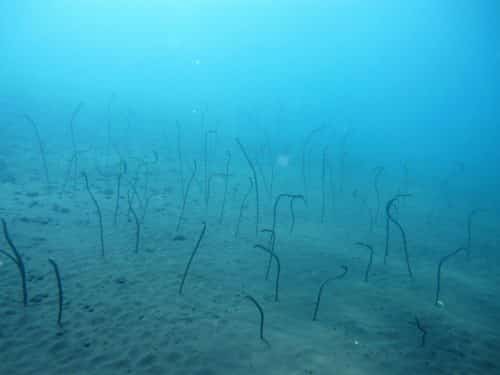
We loved it so much we dived it again the next day.
Japanese Wreck
Another ridiculously accessible shore dive in Amed is the Japanese Wreck. It’s shallow and often used as a snorkeling site as well. We’d heard great things about it, even though the maximum depth is only 12m, we wanted to give it go.
The dive is laid-back and boasts lots of small critters, like nudibranch and colorful reef fish. As usual, big soft corals and sea fans, all brilliantly colored. If you’re up for a longer dive, swim off the slope until about 35-meters – there’s a coral plateau waiting to be discovered.
Jemeluk Bay
We also wanted to explore the bay which was just a 5-minute scooter ride from our guesthouse. Jemeluk Bay is a large area hosting several relatively easy dive sites.
On the eastern side of the bay is Jemeluk Drop-Off AKA Jemeluk Wall. As the name suggests, the rocky, jagged reef drops down to depths of roughly 40m or more. We followed the reef with our right shoulder and surfaced at the eastern point of the bay. Another great dive with loads of healthy barrel sponges, soft corals, and swarms of small tropical reef fish – especially in the current at the end of the dive. Look out into the blue for the chance to spot some bigger pelagics!
***********************************
This literally just barely scratches the surface of the diving in East Bali. There are some truly amazing local dives that we didn’t have time for, and some that lie even further off Amed’s east coast; Nusa Lembongan and Nusa Penida. If you’re looking for some intense diving with strong currents and mind-blowing marine life – head here after Amed.
The diving we experienced in Amed and Tulamban guaranteed that we’ll return again one day. Not only was the diving top-notch, the ease in which we were able to dive was incredible. Of course, if you’re not a certified and very experienced diver, I would never suggest diving on your own. And in Amed, there’s no need to anyway – there are plenty of small, local diving shops dying to take you beneath the surface.
Amed and the rest of Bali are stunning regardless of whether or not you’re a scuba diver. From viewpoints, scenic motorbike drives, Hindu cliffside temples, miles of beaches, and consistently epic swell – Bali never disappoints.

